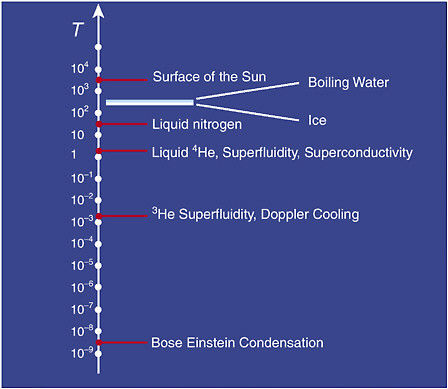Wired has an article about the activity in ultracold physics
Ultracold atoms could enable precise non-GPS navigation by using measurements based on the Earth’s rotation. Very precise measurements of the strength of magnetic or gravitational fields can be used to find oil.
This is only part of the revolution from measuring and controlling the quantum world.
Atomic, molecular, and optical (AMO) science is making great strides as described in this 230 page pdf “Controlling the Quantum World: The Science of Atoms, Molecules, and Photons (2007)” by the Board on Physics and Astronomy.
Revolutionary new methods to measure space and time have emerged within the last decade from a convergence of technologies in coherent control of ultrafast lasers and ultracold atoms. This new capability creates unprecedented new research opportunities.
Ultracold AMO physics was the most spectacularly successful new AMO research area of the past decade and led to the development of coherent quantum gases. This new field is poised to contribute significantly to the resolution of important fundamental problems in condensed matter science and in plasma physics, bringing with it new interdisciplinary opportunities.
High-intensity and short-wavelength sources such as new x-ray freeelectron lasers promise significant advances in AMO science, condensed matter physics and materials research, chemistry, medicine, and defenserelated science.
Ultrafast quantum control will unveil the internal motion of atoms within molecules, and of electrons within atoms, to a degree thought impossible only a decade ago. This capability is sparking a revolution in the imaging and coherent control of quantum processes and will be among the most fruitful new areas of AMO science in the next 10 years.
Quantum engineering on the nanoscale of tens to hundreds of atomic diameters has led to new opportunities for atom-by-atom control of quantum structures using the techniques of AMO science. Compelling opportunities in both molecular science and photon science are expected to have far-reaching societal applications.
Quantum information is a rapidly growing research area in AMO science and one that faces special challenges owing to its potential application for data security and encryption. Multiple approaches to quantum computing and communication are likely to be fruitful in the coming decade, and open international exchange of people and information is critical in order to realize the maximum benefit.

Temperature scale in powers of 10. Note: The low temperatures are farther away from our temperature than our temperature is from the surface of the sun

Using optical lattices—formed by counterpropagating lasers producing standing electromagnetic waves—one can control to an unprecedented degree the environment in which the atoms sit. For example, one can produce lattices in one, two, and three dimensions with a wide variety of lattice spacings and structures in which neutral atoms can be trapped.

Brightness comparison between current and future sources of x rays generated in laboratory x-ray lasers or at accelerators. Sources shown are the National Synchrotron Light Source (NSLS) at Brookhaven National Laboratory; Advanced Light Source (ALS) at Lawrence Berkeley National Laboratory; Advanced Photon Source (APS) at Argonne National Laboratory; European Synchrotron Research Facility (ESRF); Subpicosecond Pulse Source (SPPS) at the Stanford Linear Accelerator Center (SLAG); Linac Coherent Light Source (LCLS) at SLAG; the vacuum ultraviolet XFEL at the TESLA Test Facility at DESY, Hamburg, Germany (VUV-FEL); and the future European X-Ray Laser Project XFEL. Years on the right edge of the diagram denote approximate commissioning dates. SOURCE: R.W.Lee, Lawrence Livermore National Laboratory.

Brian Wang is a Futurist Thought Leader and a popular Science blogger with 1 million readers per month. His blog Nextbigfuture.com is ranked #1 Science News Blog. It covers many disruptive technology and trends including Space, Robotics, Artificial Intelligence, Medicine, Anti-aging Biotechnology, and Nanotechnology.
Known for identifying cutting edge technologies, he is currently a Co-Founder of a startup and fundraiser for high potential early-stage companies. He is the Head of Research for Allocations for deep technology investments and an Angel Investor at Space Angels.
A frequent speaker at corporations, he has been a TEDx speaker, a Singularity University speaker and guest at numerous interviews for radio and podcasts. He is open to public speaking and advising engagements.

